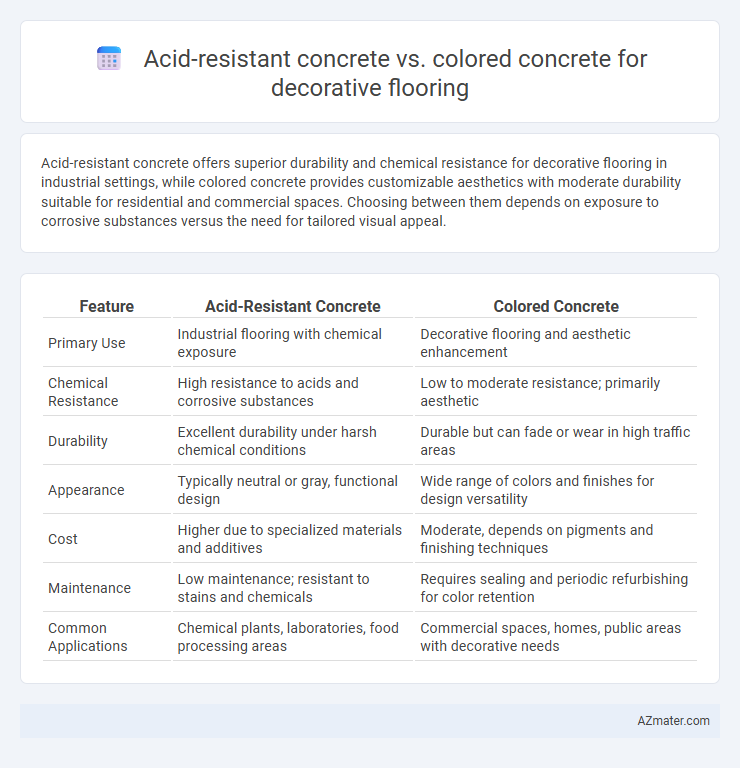Acid-resistant concrete offers superior durability and chemical resistance for decorative flooring in industrial settings, while colored concrete provides customizable aesthetics with moderate durability suitable for residential and commercial spaces. Choosing between them depends on exposure to corrosive substances versus the need for tailored visual appeal.
Table of Comparison
| Feature | Acid-Resistant Concrete | Colored Concrete |
|---|---|---|
| Primary Use | Industrial flooring with chemical exposure | Decorative flooring and aesthetic enhancement |
| Chemical Resistance | High resistance to acids and corrosive substances | Low to moderate resistance; primarily aesthetic |
| Durability | Excellent durability under harsh chemical conditions | Durable but can fade or wear in high traffic areas |
| Appearance | Typically neutral or gray, functional design | Wide range of colors and finishes for design versatility |
| Cost | Higher due to specialized materials and additives | Moderate, depends on pigments and finishing techniques |
| Maintenance | Low maintenance; resistant to stains and chemicals | Requires sealing and periodic refurbishing for color retention |
| Common Applications | Chemical plants, laboratories, food processing areas | Commercial spaces, homes, public areas with decorative needs |
Introduction to Decorative Concrete Flooring
Decorative concrete flooring enhances both aesthetic appeal and functionality in residential and commercial spaces by offering diverse customization options such as acid-resistant and colored concrete. Acid-resistant concrete excels in environments requiring chemical durability and protection against corrosive substances, making it ideal for industrial and laboratory floors. Colored concrete, incorporating pigments and stains, provides vibrant, customizable designs suited for decorative purposes in retail, hospitality, and residential applications.
Overview of Acid-Resistant Concrete
Acid-resistant concrete is specifically formulated to withstand corrosive environments, making it ideal for industrial and chemical facility flooring where exposure to acids is frequent. It incorporates specialized aggregates and acid-proof binders to ensure long-term durability and resistance to chemical damage, outperforming standard colored concrete options in harsh conditions. Unlike colored concrete, which primarily enhances aesthetic appeal, acid-resistant concrete prioritizes protection against chemical degradation while still allowing for decorative finishes.
Key Features of Colored Concrete
Colored concrete offers high versatility with a range of pigments that create vibrant, uniform hues or subtle earth tones, enhancing aesthetic appeal for decorative flooring. It provides excellent durability, resisting fading and wear under foot traffic and environmental exposure, making it ideal for both indoor and outdoor spaces. Unlike acid-resistant concrete, colored concrete emphasizes visual customization without compromising structural integrity or surface finish quality.
Durability: Acid-Resistant vs Colored Concrete
Acid-resistant concrete offers superior durability in environments exposed to corrosive chemicals, maintaining structural integrity where colored concrete may degrade or stain over time. Colored concrete provides aesthetic versatility but typically lacks the chemical resilience necessary for heavy-duty industrial settings. Choosing acid-resistant concrete enhances longevity and reduces maintenance costs in applications requiring both decorative appeal and robust protection.
Aesthetic Options and Color Variations
Acid-resistant concrete offers limited aesthetic options, primarily focusing on functional performance with muted color variations to withstand harsh chemical environments. Colored concrete provides extensive color variations and customizable pigmentation, enabling vibrant, decorative flooring designs that enhance visual appeal. Decorative flooring projects seeking a balance between durability and aesthetic versatility often prefer colored concrete for its wide range of hues and finishes.
Maintenance Requirements and Longevity
Acid-resistant concrete offers superior chemical resistance and durability, making it ideal for environments with frequent exposure to acids, thereby reducing maintenance frequency and prolonging structural integrity. Colored concrete provides aesthetic versatility with UV-resistant pigments but may require periodic resealing and color touch-ups to maintain vibrancy and surface protection. While acid-resistant concrete excels in longevity under harsh conditions, colored concrete demands more maintenance to preserve its decorative appeal over time.
Cost Comparison and Budget Considerations
Acid-resistant concrete typically incurs higher initial costs due to the specialized materials and additives required to enhance chemical resistance, making it a more expensive option compared to colored concrete. Colored concrete offers a budget-friendly alternative with various pigmentation techniques available at lower material and labor costs, ideal for decorative flooring where budget constraints are critical. Long-term maintenance and durability should also be factored into budget considerations, as acid-resistant concrete can reduce repair costs in chemically aggressive environments.
Ideal Applications for Acid-Resistant Concrete
Acid-resistant concrete is ideal for industrial environments such as chemical plants, laboratories, and food processing facilities where floors are exposed to harsh acidic substances, ensuring longevity and safety. Unlike colored concrete, which primarily enhances aesthetic appeal for residential and commercial interiors, acid-resistant concrete prioritizes functionality and durability against corrosive chemicals. This makes acid-resistant concrete the preferred choice for decorative flooring in settings demanding high-performance materials that withstand chemical wear.
Best Uses for Colored Concrete in Decorative Flooring
Colored concrete excels in decorative flooring applications where aesthetic appeal and customization are priorities, such as retail spaces, residential interiors, and commercial lobbies. Its ability to incorporate a wide range of pigments and patterns enhances design versatility, making it ideal for creating vibrant and unique floor finishes. Compared to acid-resistant concrete, which is primarily used for environments requiring chemical durability, colored concrete offers superior visual impact and personalization options.
Choosing the Right Concrete Solution for Your Project
Acid-resistant concrete provides superior durability and chemical resistance, making it ideal for industrial or laboratory decorative flooring exposed to harsh substances. Colored concrete offers versatile aesthetic appeal with customizable shades and patterns, suitable for residential or commercial spaces prioritizing design. Evaluating environmental exposure, maintenance needs, and visual goals ensures the selection of the optimal concrete solution tailored to specific project requirements.

Infographic: Acid-resistant concrete vs Colored concrete for Decorative flooring
 azmater.com
azmater.com